Report: Social and Cultural Impact of ICT Use on Cyber Security
VerifiedAdded on 2022/09/08
|15
|4018
|9
Report
AI Summary
This report explores the social and cultural impacts of Information and Communication Technology (ICT) on cyber security, using the Cambridge Analytica scandal as a case study. It identifies key aspects of cyber security, including analytics, external and internal threat coverage, compliance, and risk management. The report analyzes the positive social impacts of ICT, such as its influence on health and education, its role in fostering business innovation, and its enhancement of communication, information access, and interactions. It also delves into the cultural impacts, focusing on changes in values, beliefs, and behaviors due to ICT and cyber security concerns. The report concludes by emphasizing the critical importance of understanding and addressing the social and cultural dimensions of cyber security in the digital age.
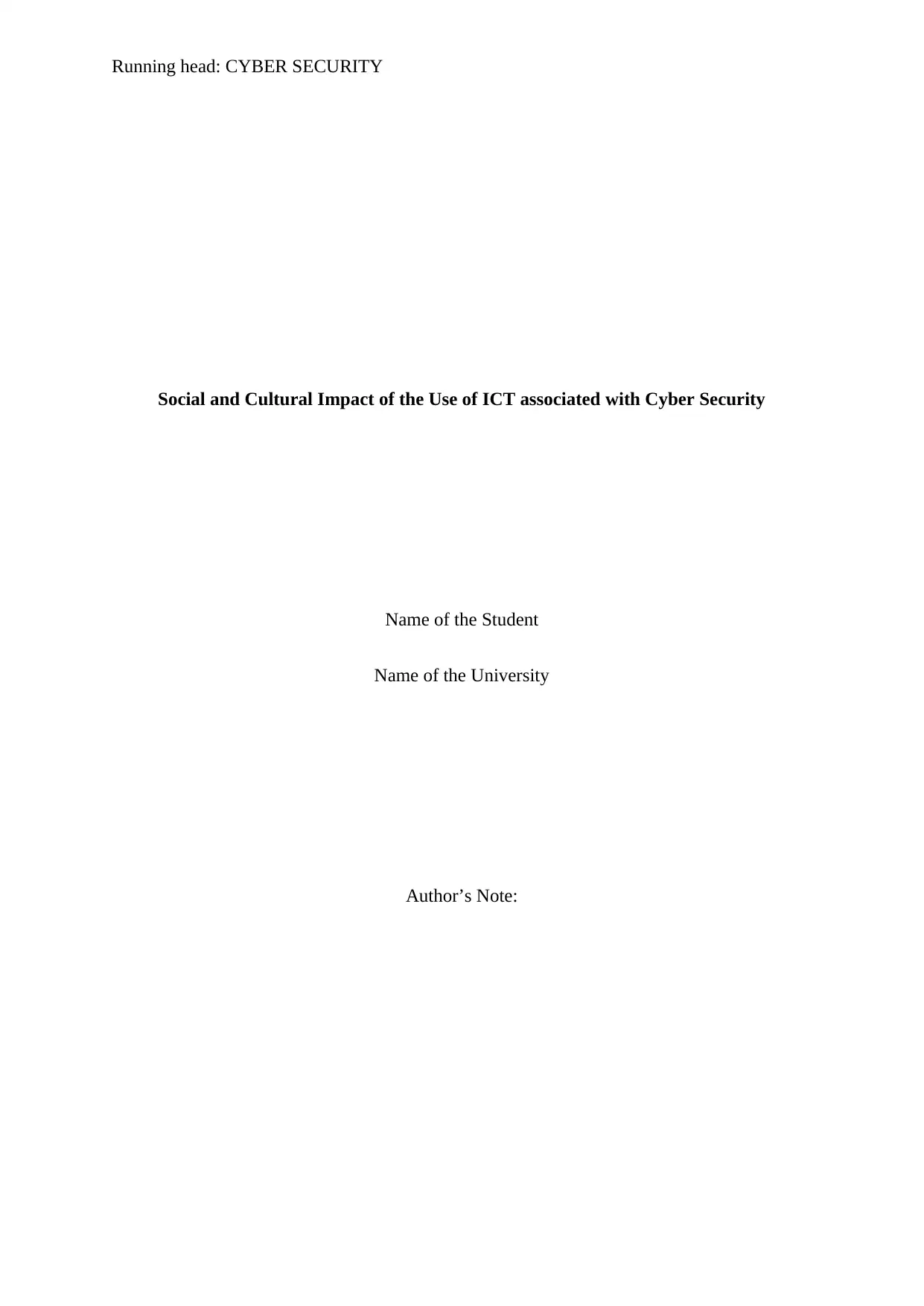
Running head: CYBER SECURITY
Social and Cultural Impact of the Use of ICT associated with Cyber Security
Name of the Student
Name of the University
Author’s Note:
Social and Cultural Impact of the Use of ICT associated with Cyber Security
Name of the Student
Name of the University
Author’s Note:
Paraphrase This Document
Need a fresh take? Get an instant paraphrase of this document with our AI Paraphraser
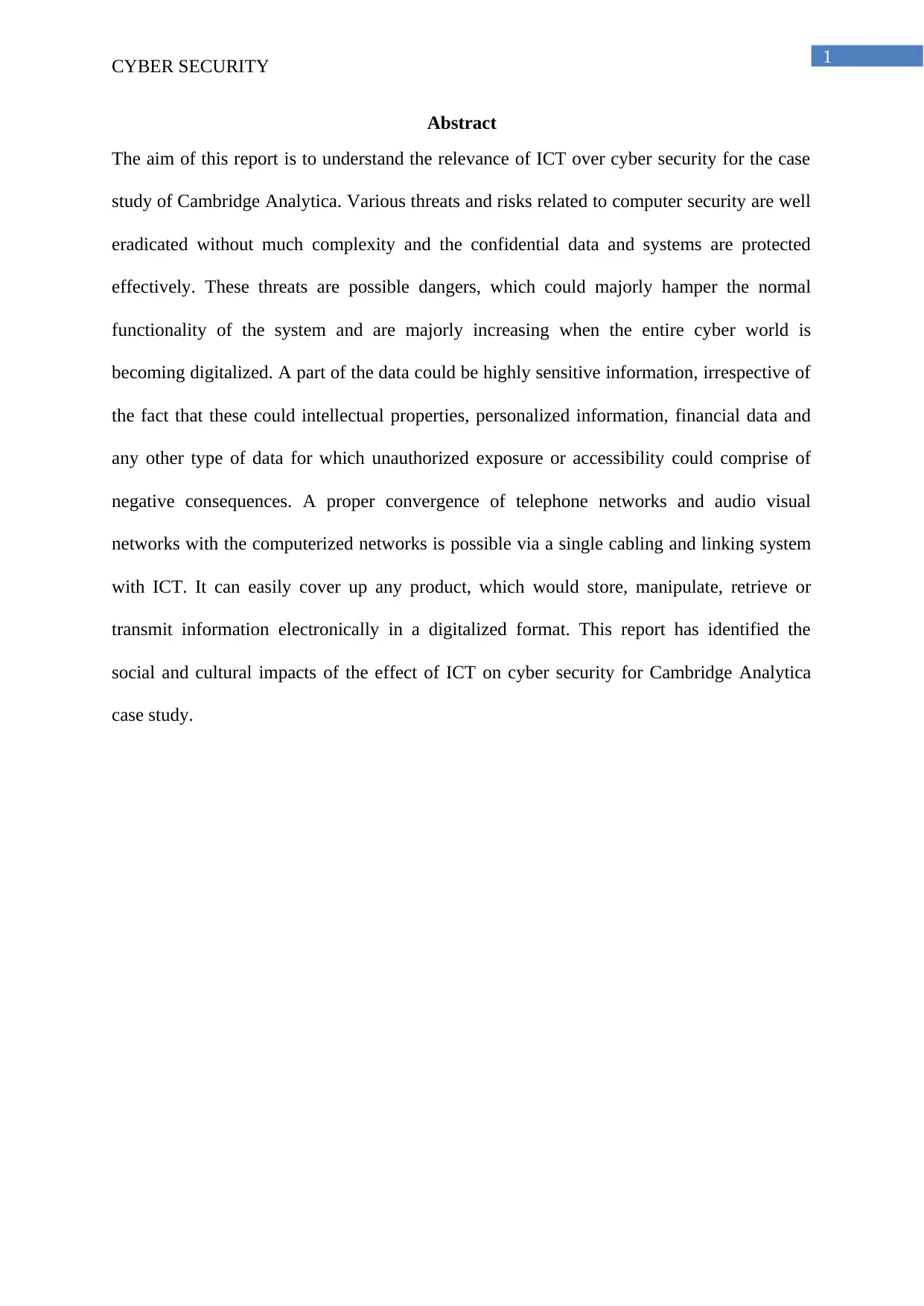
1
CYBER SECURITY
Abstract
The aim of this report is to understand the relevance of ICT over cyber security for the case
study of Cambridge Analytica. Various threats and risks related to computer security are well
eradicated without much complexity and the confidential data and systems are protected
effectively. These threats are possible dangers, which could majorly hamper the normal
functionality of the system and are majorly increasing when the entire cyber world is
becoming digitalized. A part of the data could be highly sensitive information, irrespective of
the fact that these could intellectual properties, personalized information, financial data and
any other type of data for which unauthorized exposure or accessibility could comprise of
negative consequences. A proper convergence of telephone networks and audio visual
networks with the computerized networks is possible via a single cabling and linking system
with ICT. It can easily cover up any product, which would store, manipulate, retrieve or
transmit information electronically in a digitalized format. This report has identified the
social and cultural impacts of the effect of ICT on cyber security for Cambridge Analytica
case study.
CYBER SECURITY
Abstract
The aim of this report is to understand the relevance of ICT over cyber security for the case
study of Cambridge Analytica. Various threats and risks related to computer security are well
eradicated without much complexity and the confidential data and systems are protected
effectively. These threats are possible dangers, which could majorly hamper the normal
functionality of the system and are majorly increasing when the entire cyber world is
becoming digitalized. A part of the data could be highly sensitive information, irrespective of
the fact that these could intellectual properties, personalized information, financial data and
any other type of data for which unauthorized exposure or accessibility could comprise of
negative consequences. A proper convergence of telephone networks and audio visual
networks with the computerized networks is possible via a single cabling and linking system
with ICT. It can easily cover up any product, which would store, manipulate, retrieve or
transmit information electronically in a digitalized format. This report has identified the
social and cultural impacts of the effect of ICT on cyber security for Cambridge Analytica
case study.
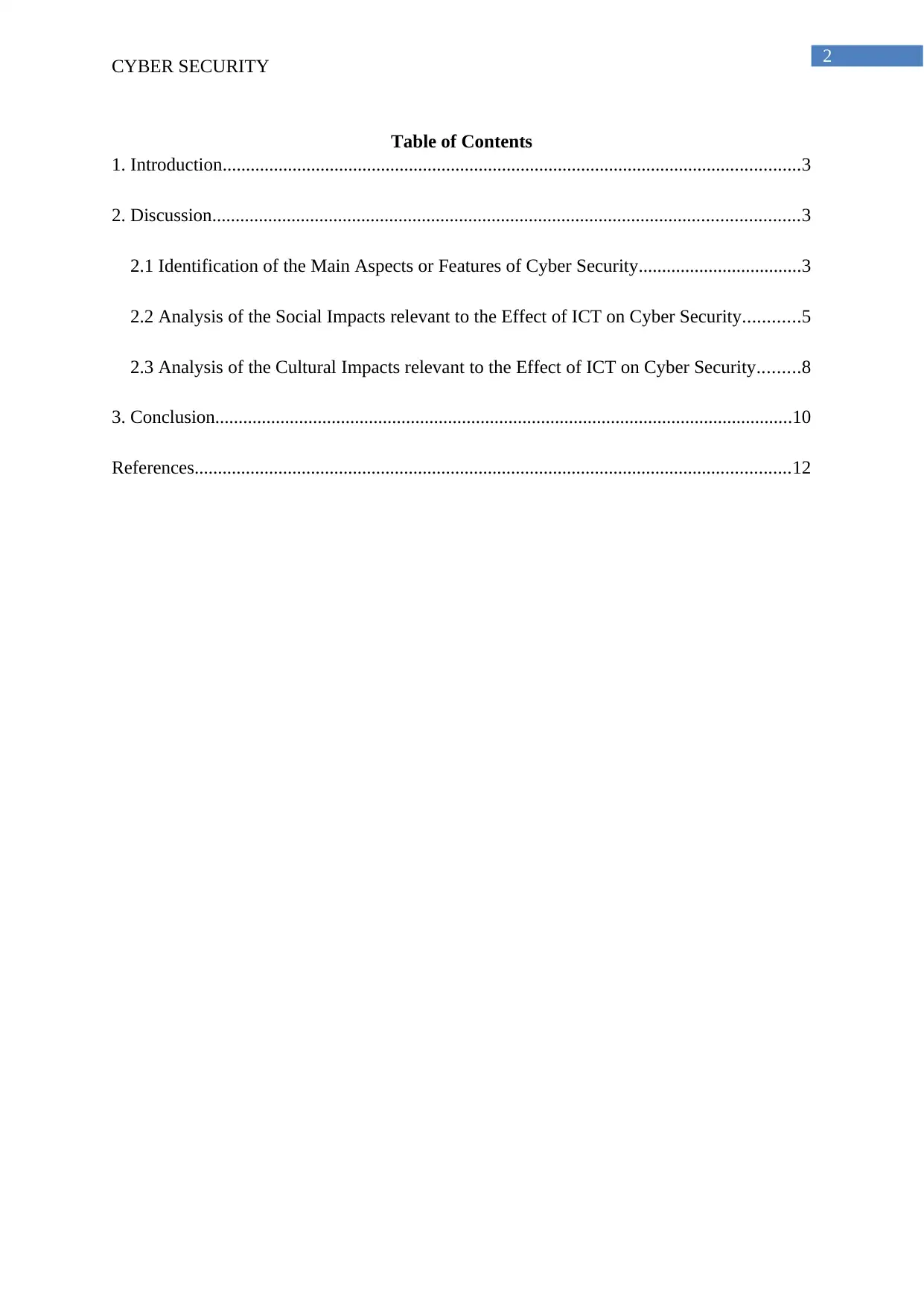
2
CYBER SECURITY
Table of Contents
1. Introduction............................................................................................................................3
2. Discussion..............................................................................................................................3
2.1 Identification of the Main Aspects or Features of Cyber Security...................................3
2.2 Analysis of the Social Impacts relevant to the Effect of ICT on Cyber Security............5
2.3 Analysis of the Cultural Impacts relevant to the Effect of ICT on Cyber Security.........8
3. Conclusion............................................................................................................................10
References................................................................................................................................12
CYBER SECURITY
Table of Contents
1. Introduction............................................................................................................................3
2. Discussion..............................................................................................................................3
2.1 Identification of the Main Aspects or Features of Cyber Security...................................3
2.2 Analysis of the Social Impacts relevant to the Effect of ICT on Cyber Security............5
2.3 Analysis of the Cultural Impacts relevant to the Effect of ICT on Cyber Security.........8
3. Conclusion............................................................................................................................10
References................................................................................................................................12
⊘ This is a preview!⊘
Do you want full access?
Subscribe today to unlock all pages.

Trusted by 1+ million students worldwide
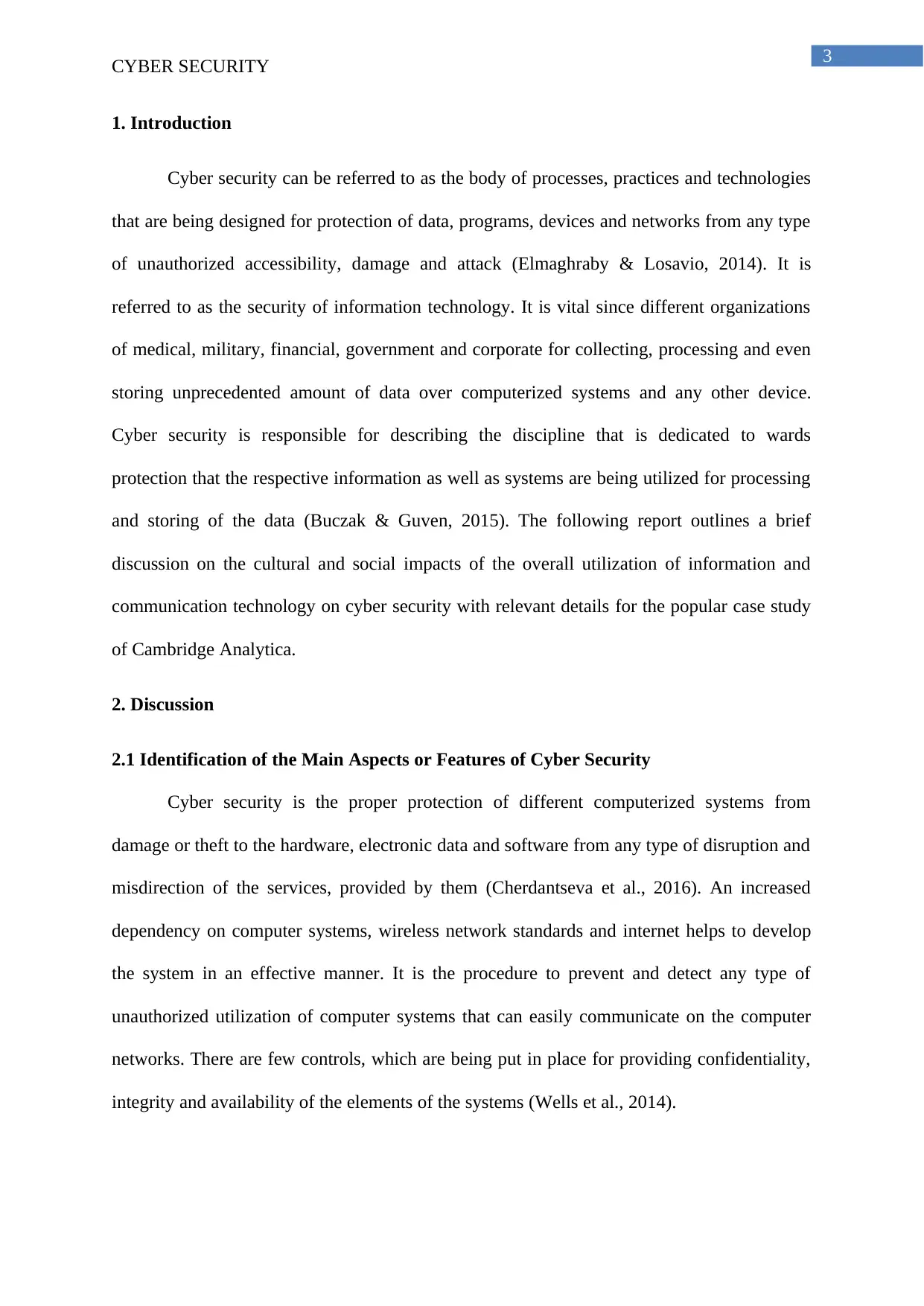
3
CYBER SECURITY
1. Introduction
Cyber security can be referred to as the body of processes, practices and technologies
that are being designed for protection of data, programs, devices and networks from any type
of unauthorized accessibility, damage and attack (Elmaghraby & Losavio, 2014). It is
referred to as the security of information technology. It is vital since different organizations
of medical, military, financial, government and corporate for collecting, processing and even
storing unprecedented amount of data over computerized systems and any other device.
Cyber security is responsible for describing the discipline that is dedicated to wards
protection that the respective information as well as systems are being utilized for processing
and storing of the data (Buczak & Guven, 2015). The following report outlines a brief
discussion on the cultural and social impacts of the overall utilization of information and
communication technology on cyber security with relevant details for the popular case study
of Cambridge Analytica.
2. Discussion
2.1 Identification of the Main Aspects or Features of Cyber Security
Cyber security is the proper protection of different computerized systems from
damage or theft to the hardware, electronic data and software from any type of disruption and
misdirection of the services, provided by them (Cherdantseva et al., 2016). An increased
dependency on computer systems, wireless network standards and internet helps to develop
the system in an effective manner. It is the procedure to prevent and detect any type of
unauthorized utilization of computer systems that can easily communicate on the computer
networks. There are few controls, which are being put in place for providing confidentiality,
integrity and availability of the elements of the systems (Wells et al., 2014).
CYBER SECURITY
1. Introduction
Cyber security can be referred to as the body of processes, practices and technologies
that are being designed for protection of data, programs, devices and networks from any type
of unauthorized accessibility, damage and attack (Elmaghraby & Losavio, 2014). It is
referred to as the security of information technology. It is vital since different organizations
of medical, military, financial, government and corporate for collecting, processing and even
storing unprecedented amount of data over computerized systems and any other device.
Cyber security is responsible for describing the discipline that is dedicated to wards
protection that the respective information as well as systems are being utilized for processing
and storing of the data (Buczak & Guven, 2015). The following report outlines a brief
discussion on the cultural and social impacts of the overall utilization of information and
communication technology on cyber security with relevant details for the popular case study
of Cambridge Analytica.
2. Discussion
2.1 Identification of the Main Aspects or Features of Cyber Security
Cyber security is the proper protection of different computerized systems from
damage or theft to the hardware, electronic data and software from any type of disruption and
misdirection of the services, provided by them (Cherdantseva et al., 2016). An increased
dependency on computer systems, wireless network standards and internet helps to develop
the system in an effective manner. It is the procedure to prevent and detect any type of
unauthorized utilization of computer systems that can easily communicate on the computer
networks. There are few controls, which are being put in place for providing confidentiality,
integrity and availability of the elements of the systems (Wells et al., 2014).
Paraphrase This Document
Need a fresh take? Get an instant paraphrase of this document with our AI Paraphraser
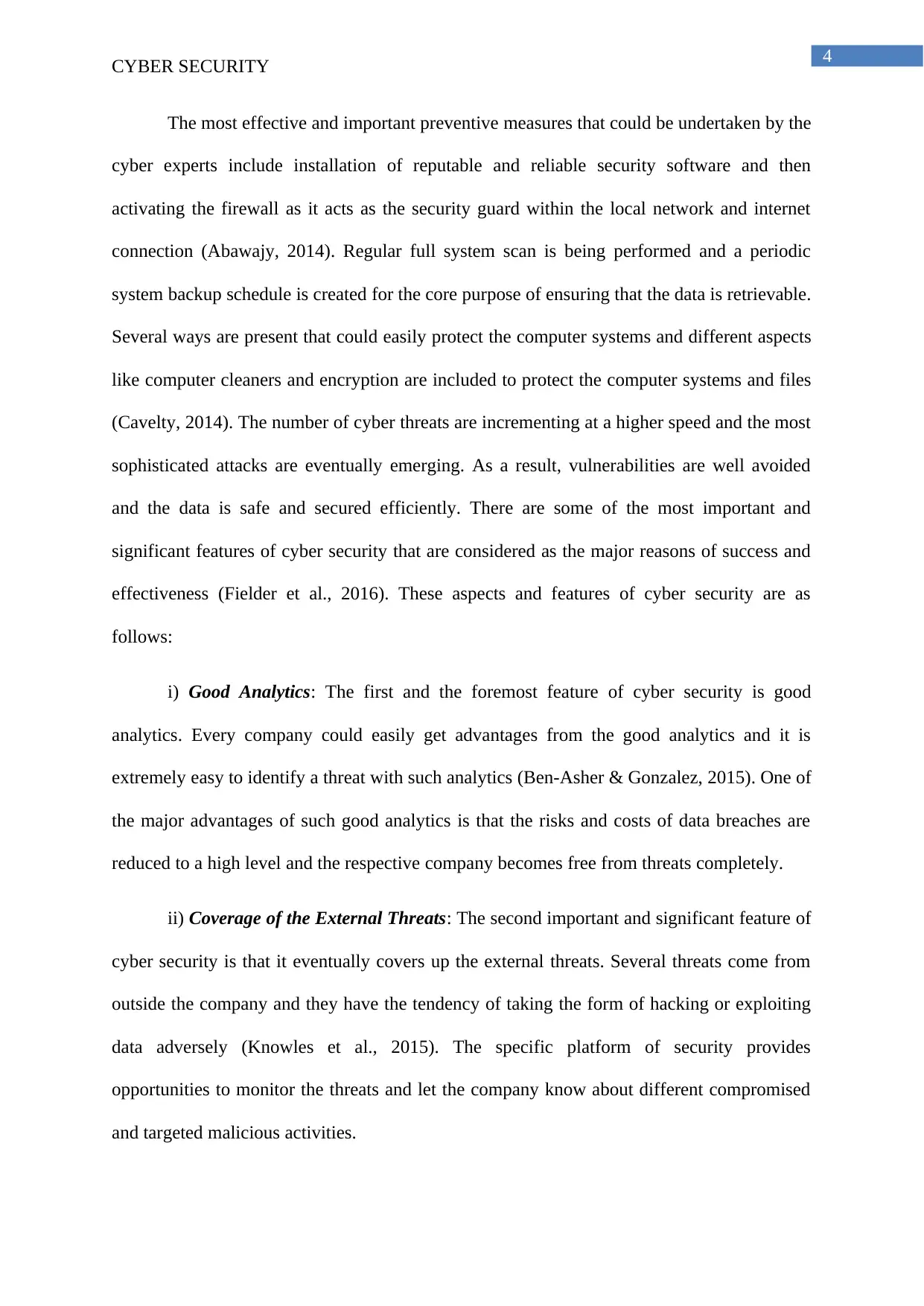
4
CYBER SECURITY
The most effective and important preventive measures that could be undertaken by the
cyber experts include installation of reputable and reliable security software and then
activating the firewall as it acts as the security guard within the local network and internet
connection (Abawajy, 2014). Regular full system scan is being performed and a periodic
system backup schedule is created for the core purpose of ensuring that the data is retrievable.
Several ways are present that could easily protect the computer systems and different aspects
like computer cleaners and encryption are included to protect the computer systems and files
(Cavelty, 2014). The number of cyber threats are incrementing at a higher speed and the most
sophisticated attacks are eventually emerging. As a result, vulnerabilities are well avoided
and the data is safe and secured efficiently. There are some of the most important and
significant features of cyber security that are considered as the major reasons of success and
effectiveness (Fielder et al., 2016). These aspects and features of cyber security are as
follows:
i) Good Analytics: The first and the foremost feature of cyber security is good
analytics. Every company could easily get advantages from the good analytics and it is
extremely easy to identify a threat with such analytics (Ben-Asher & Gonzalez, 2015). One of
the major advantages of such good analytics is that the risks and costs of data breaches are
reduced to a high level and the respective company becomes free from threats completely.
ii) Coverage of the External Threats: The second important and significant feature of
cyber security is that it eventually covers up the external threats. Several threats come from
outside the company and they have the tendency of taking the form of hacking or exploiting
data adversely (Knowles et al., 2015). The specific platform of security provides
opportunities to monitor the threats and let the company know about different compromised
and targeted malicious activities.
CYBER SECURITY
The most effective and important preventive measures that could be undertaken by the
cyber experts include installation of reputable and reliable security software and then
activating the firewall as it acts as the security guard within the local network and internet
connection (Abawajy, 2014). Regular full system scan is being performed and a periodic
system backup schedule is created for the core purpose of ensuring that the data is retrievable.
Several ways are present that could easily protect the computer systems and different aspects
like computer cleaners and encryption are included to protect the computer systems and files
(Cavelty, 2014). The number of cyber threats are incrementing at a higher speed and the most
sophisticated attacks are eventually emerging. As a result, vulnerabilities are well avoided
and the data is safe and secured efficiently. There are some of the most important and
significant features of cyber security that are considered as the major reasons of success and
effectiveness (Fielder et al., 2016). These aspects and features of cyber security are as
follows:
i) Good Analytics: The first and the foremost feature of cyber security is good
analytics. Every company could easily get advantages from the good analytics and it is
extremely easy to identify a threat with such analytics (Ben-Asher & Gonzalez, 2015). One of
the major advantages of such good analytics is that the risks and costs of data breaches are
reduced to a high level and the respective company becomes free from threats completely.
ii) Coverage of the External Threats: The second important and significant feature of
cyber security is that it eventually covers up the external threats. Several threats come from
outside the company and they have the tendency of taking the form of hacking or exploiting
data adversely (Knowles et al., 2015). The specific platform of security provides
opportunities to monitor the threats and let the company know about different compromised
and targeted malicious activities.
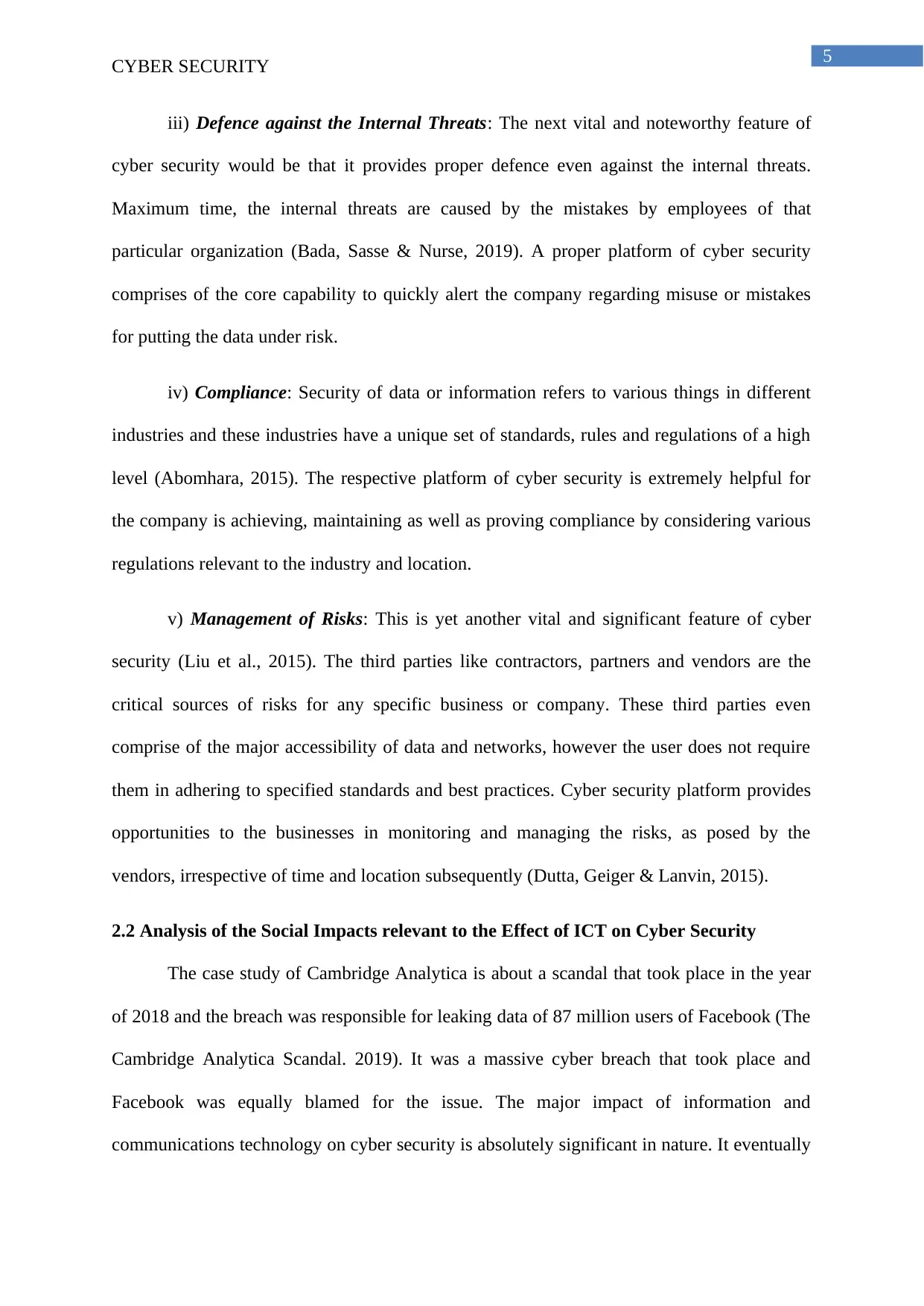
5
CYBER SECURITY
iii) Defence against the Internal Threats: The next vital and noteworthy feature of
cyber security would be that it provides proper defence even against the internal threats.
Maximum time, the internal threats are caused by the mistakes by employees of that
particular organization (Bada, Sasse & Nurse, 2019). A proper platform of cyber security
comprises of the core capability to quickly alert the company regarding misuse or mistakes
for putting the data under risk.
iv) Compliance: Security of data or information refers to various things in different
industries and these industries have a unique set of standards, rules and regulations of a high
level (Abomhara, 2015). The respective platform of cyber security is extremely helpful for
the company is achieving, maintaining as well as proving compliance by considering various
regulations relevant to the industry and location.
v) Management of Risks: This is yet another vital and significant feature of cyber
security (Liu et al., 2015). The third parties like contractors, partners and vendors are the
critical sources of risks for any specific business or company. These third parties even
comprise of the major accessibility of data and networks, however the user does not require
them in adhering to specified standards and best practices. Cyber security platform provides
opportunities to the businesses in monitoring and managing the risks, as posed by the
vendors, irrespective of time and location subsequently (Dutta, Geiger & Lanvin, 2015).
2.2 Analysis of the Social Impacts relevant to the Effect of ICT on Cyber Security
The case study of Cambridge Analytica is about a scandal that took place in the year
of 2018 and the breach was responsible for leaking data of 87 million users of Facebook (The
Cambridge Analytica Scandal. 2019). It was a massive cyber breach that took place and
Facebook was equally blamed for the issue. The major impact of information and
communications technology on cyber security is absolutely significant in nature. It eventually
CYBER SECURITY
iii) Defence against the Internal Threats: The next vital and noteworthy feature of
cyber security would be that it provides proper defence even against the internal threats.
Maximum time, the internal threats are caused by the mistakes by employees of that
particular organization (Bada, Sasse & Nurse, 2019). A proper platform of cyber security
comprises of the core capability to quickly alert the company regarding misuse or mistakes
for putting the data under risk.
iv) Compliance: Security of data or information refers to various things in different
industries and these industries have a unique set of standards, rules and regulations of a high
level (Abomhara, 2015). The respective platform of cyber security is extremely helpful for
the company is achieving, maintaining as well as proving compliance by considering various
regulations relevant to the industry and location.
v) Management of Risks: This is yet another vital and significant feature of cyber
security (Liu et al., 2015). The third parties like contractors, partners and vendors are the
critical sources of risks for any specific business or company. These third parties even
comprise of the major accessibility of data and networks, however the user does not require
them in adhering to specified standards and best practices. Cyber security platform provides
opportunities to the businesses in monitoring and managing the risks, as posed by the
vendors, irrespective of time and location subsequently (Dutta, Geiger & Lanvin, 2015).
2.2 Analysis of the Social Impacts relevant to the Effect of ICT on Cyber Security
The case study of Cambridge Analytica is about a scandal that took place in the year
of 2018 and the breach was responsible for leaking data of 87 million users of Facebook (The
Cambridge Analytica Scandal. 2019). It was a massive cyber breach that took place and
Facebook was equally blamed for the issue. The major impact of information and
communications technology on cyber security is absolutely significant in nature. It eventually
⊘ This is a preview!⊘
Do you want full access?
Subscribe today to unlock all pages.

Trusted by 1+ million students worldwide
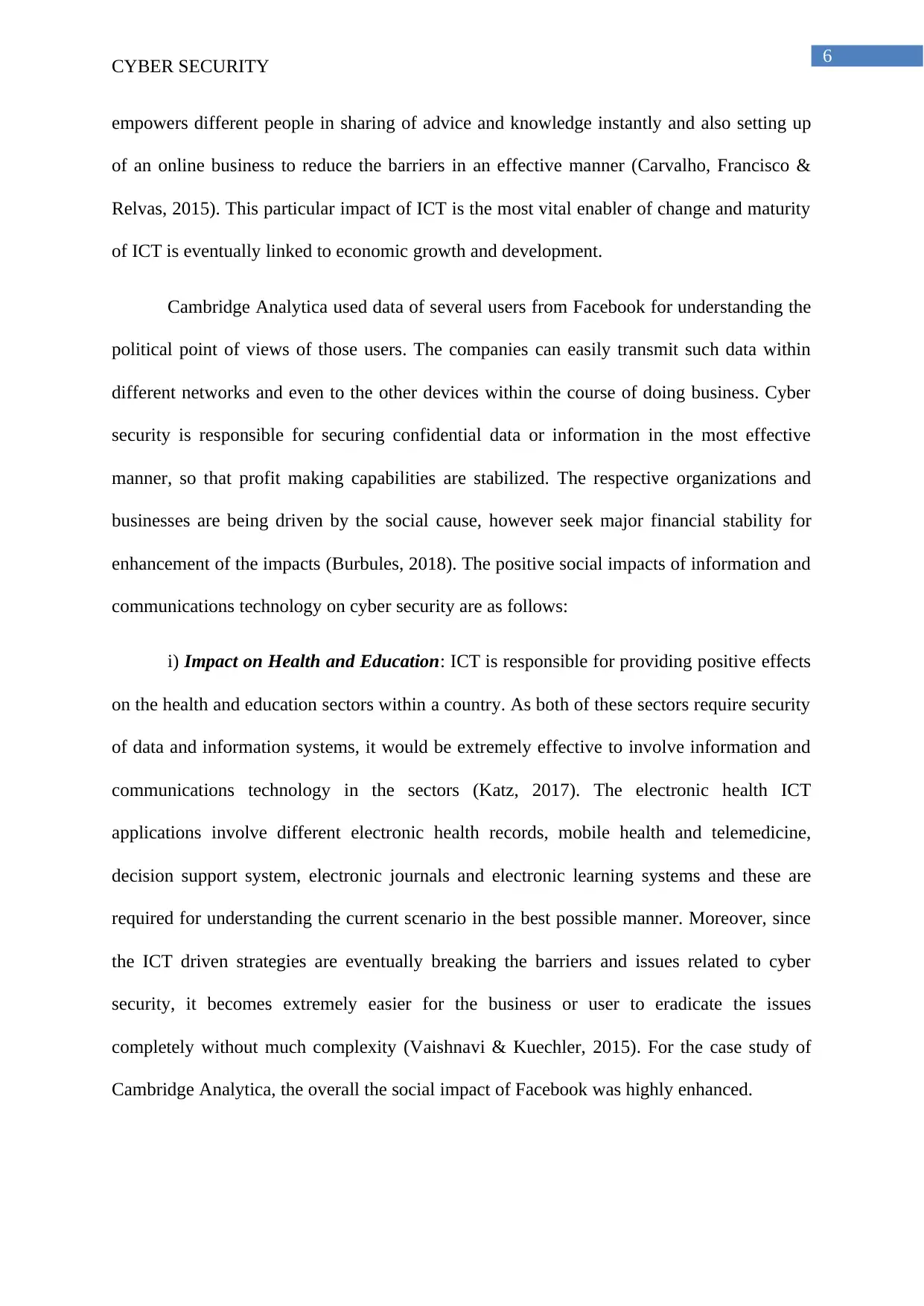
6
CYBER SECURITY
empowers different people in sharing of advice and knowledge instantly and also setting up
of an online business to reduce the barriers in an effective manner (Carvalho, Francisco &
Relvas, 2015). This particular impact of ICT is the most vital enabler of change and maturity
of ICT is eventually linked to economic growth and development.
Cambridge Analytica used data of several users from Facebook for understanding the
political point of views of those users. The companies can easily transmit such data within
different networks and even to the other devices within the course of doing business. Cyber
security is responsible for securing confidential data or information in the most effective
manner, so that profit making capabilities are stabilized. The respective organizations and
businesses are being driven by the social cause, however seek major financial stability for
enhancement of the impacts (Burbules, 2018). The positive social impacts of information and
communications technology on cyber security are as follows:
i) Impact on Health and Education: ICT is responsible for providing positive effects
on the health and education sectors within a country. As both of these sectors require security
of data and information systems, it would be extremely effective to involve information and
communications technology in the sectors (Katz, 2017). The electronic health ICT
applications involve different electronic health records, mobile health and telemedicine,
decision support system, electronic journals and electronic learning systems and these are
required for understanding the current scenario in the best possible manner. Moreover, since
the ICT driven strategies are eventually breaking the barriers and issues related to cyber
security, it becomes extremely easier for the business or user to eradicate the issues
completely without much complexity (Vaishnavi & Kuechler, 2015). For the case study of
Cambridge Analytica, the overall the social impact of Facebook was highly enhanced.
CYBER SECURITY
empowers different people in sharing of advice and knowledge instantly and also setting up
of an online business to reduce the barriers in an effective manner (Carvalho, Francisco &
Relvas, 2015). This particular impact of ICT is the most vital enabler of change and maturity
of ICT is eventually linked to economic growth and development.
Cambridge Analytica used data of several users from Facebook for understanding the
political point of views of those users. The companies can easily transmit such data within
different networks and even to the other devices within the course of doing business. Cyber
security is responsible for securing confidential data or information in the most effective
manner, so that profit making capabilities are stabilized. The respective organizations and
businesses are being driven by the social cause, however seek major financial stability for
enhancement of the impacts (Burbules, 2018). The positive social impacts of information and
communications technology on cyber security are as follows:
i) Impact on Health and Education: ICT is responsible for providing positive effects
on the health and education sectors within a country. As both of these sectors require security
of data and information systems, it would be extremely effective to involve information and
communications technology in the sectors (Katz, 2017). The electronic health ICT
applications involve different electronic health records, mobile health and telemedicine,
decision support system, electronic journals and electronic learning systems and these are
required for understanding the current scenario in the best possible manner. Moreover, since
the ICT driven strategies are eventually breaking the barriers and issues related to cyber
security, it becomes extremely easier for the business or user to eradicate the issues
completely without much complexity (Vaishnavi & Kuechler, 2015). For the case study of
Cambridge Analytica, the overall the social impact of Facebook was highly enhanced.
Paraphrase This Document
Need a fresh take? Get an instant paraphrase of this document with our AI Paraphraser
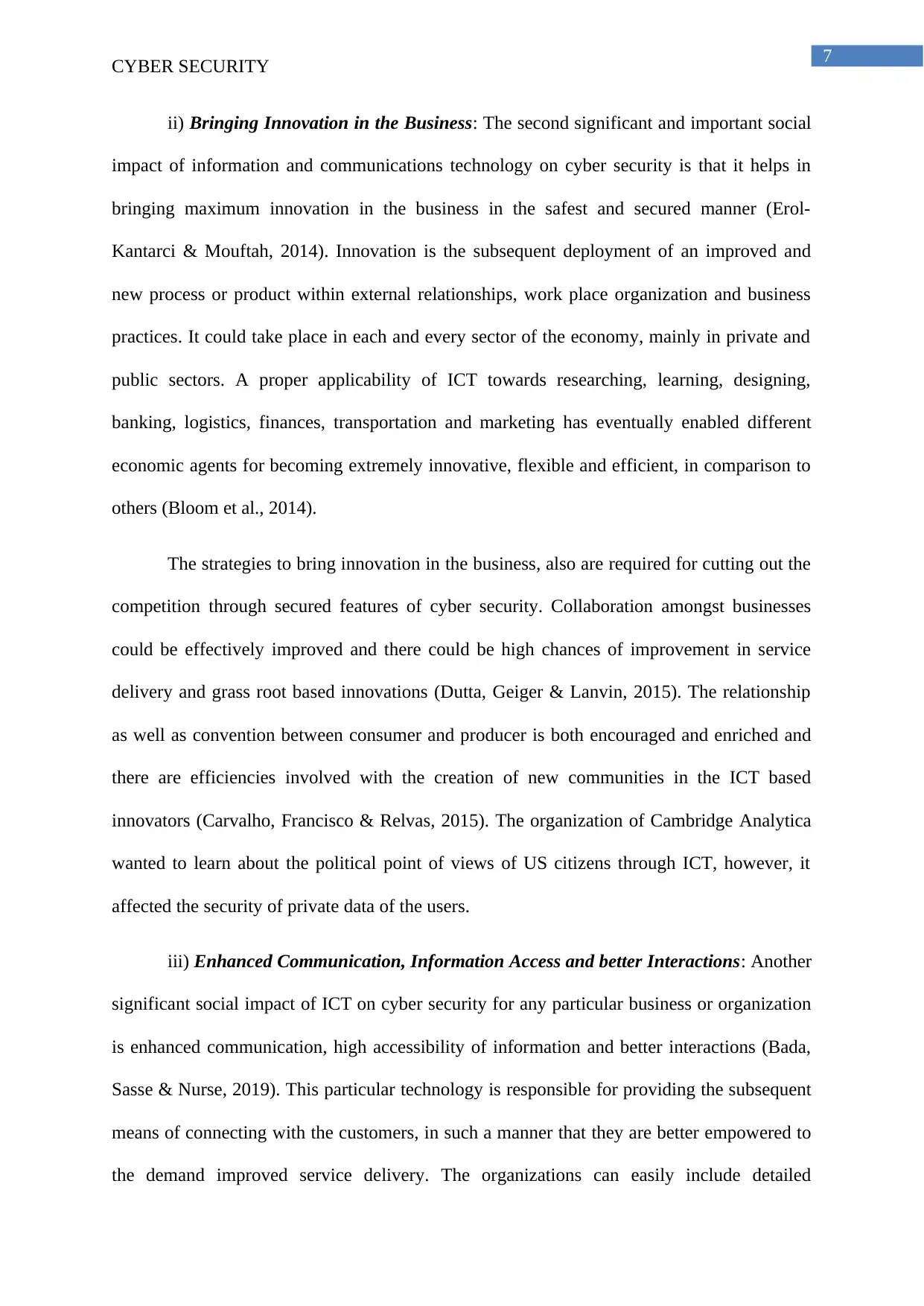
7
CYBER SECURITY
ii) Bringing Innovation in the Business: The second significant and important social
impact of information and communications technology on cyber security is that it helps in
bringing maximum innovation in the business in the safest and secured manner (Erol-
Kantarci & Mouftah, 2014). Innovation is the subsequent deployment of an improved and
new process or product within external relationships, work place organization and business
practices. It could take place in each and every sector of the economy, mainly in private and
public sectors. A proper applicability of ICT towards researching, learning, designing,
banking, logistics, finances, transportation and marketing has eventually enabled different
economic agents for becoming extremely innovative, flexible and efficient, in comparison to
others (Bloom et al., 2014).
The strategies to bring innovation in the business, also are required for cutting out the
competition through secured features of cyber security. Collaboration amongst businesses
could be effectively improved and there could be high chances of improvement in service
delivery and grass root based innovations (Dutta, Geiger & Lanvin, 2015). The relationship
as well as convention between consumer and producer is both encouraged and enriched and
there are efficiencies involved with the creation of new communities in the ICT based
innovators (Carvalho, Francisco & Relvas, 2015). The organization of Cambridge Analytica
wanted to learn about the political point of views of US citizens through ICT, however, it
affected the security of private data of the users.
iii) Enhanced Communication, Information Access and better Interactions: Another
significant social impact of ICT on cyber security for any particular business or organization
is enhanced communication, high accessibility of information and better interactions (Bada,
Sasse & Nurse, 2019). This particular technology is responsible for providing the subsequent
means of connecting with the customers, in such a manner that they are better empowered to
the demand improved service delivery. The organizations can easily include detailed
CYBER SECURITY
ii) Bringing Innovation in the Business: The second significant and important social
impact of information and communications technology on cyber security is that it helps in
bringing maximum innovation in the business in the safest and secured manner (Erol-
Kantarci & Mouftah, 2014). Innovation is the subsequent deployment of an improved and
new process or product within external relationships, work place organization and business
practices. It could take place in each and every sector of the economy, mainly in private and
public sectors. A proper applicability of ICT towards researching, learning, designing,
banking, logistics, finances, transportation and marketing has eventually enabled different
economic agents for becoming extremely innovative, flexible and efficient, in comparison to
others (Bloom et al., 2014).
The strategies to bring innovation in the business, also are required for cutting out the
competition through secured features of cyber security. Collaboration amongst businesses
could be effectively improved and there could be high chances of improvement in service
delivery and grass root based innovations (Dutta, Geiger & Lanvin, 2015). The relationship
as well as convention between consumer and producer is both encouraged and enriched and
there are efficiencies involved with the creation of new communities in the ICT based
innovators (Carvalho, Francisco & Relvas, 2015). The organization of Cambridge Analytica
wanted to learn about the political point of views of US citizens through ICT, however, it
affected the security of private data of the users.
iii) Enhanced Communication, Information Access and better Interactions: Another
significant social impact of ICT on cyber security for any particular business or organization
is enhanced communication, high accessibility of information and better interactions (Bada,
Sasse & Nurse, 2019). This particular technology is responsible for providing the subsequent
means of connecting with the customers, in such a manner that they are better empowered to
the demand improved service delivery. The organizations can easily include detailed
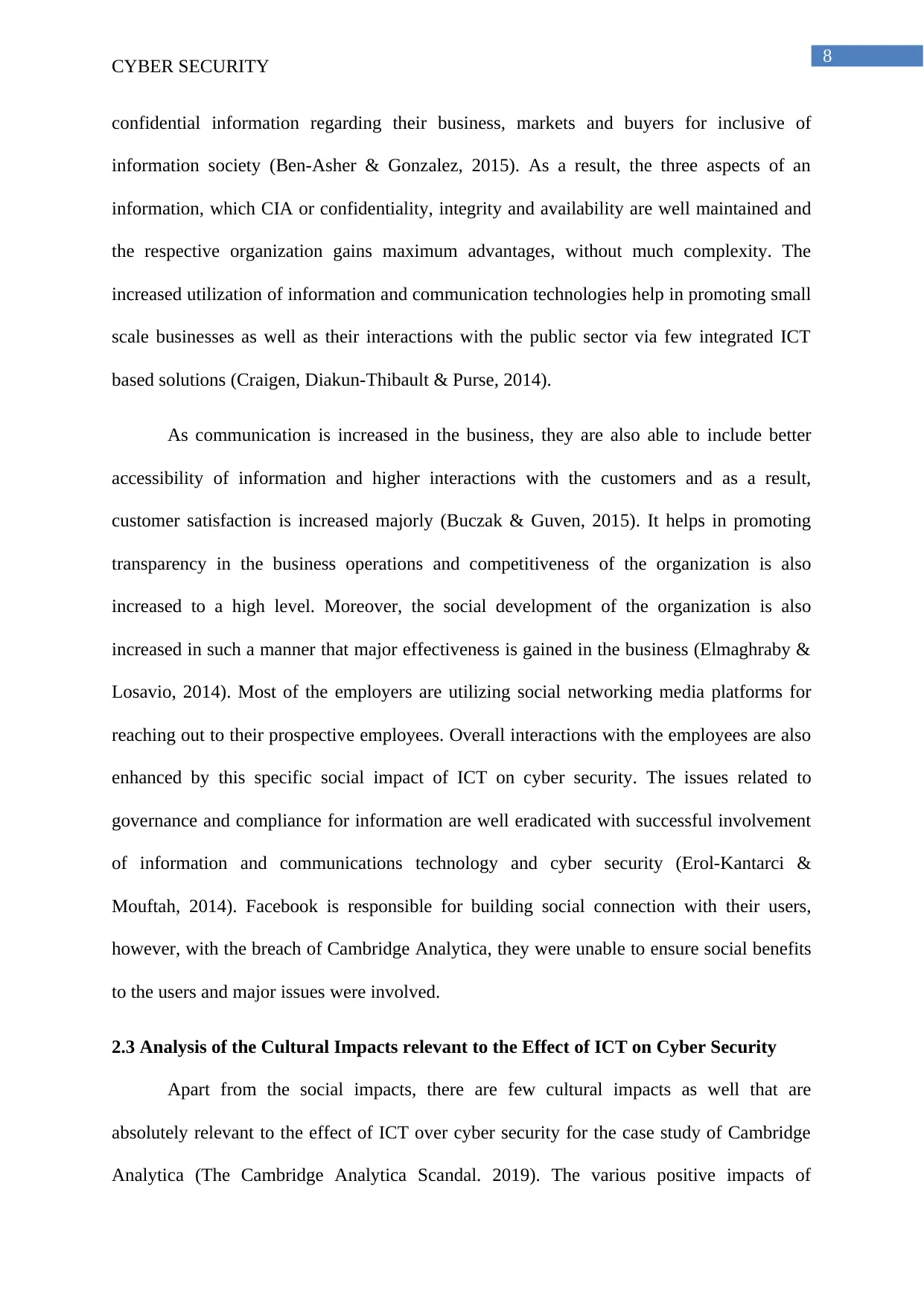
8
CYBER SECURITY
confidential information regarding their business, markets and buyers for inclusive of
information society (Ben-Asher & Gonzalez, 2015). As a result, the three aspects of an
information, which CIA or confidentiality, integrity and availability are well maintained and
the respective organization gains maximum advantages, without much complexity. The
increased utilization of information and communication technologies help in promoting small
scale businesses as well as their interactions with the public sector via few integrated ICT
based solutions (Craigen, Diakun-Thibault & Purse, 2014).
As communication is increased in the business, they are also able to include better
accessibility of information and higher interactions with the customers and as a result,
customer satisfaction is increased majorly (Buczak & Guven, 2015). It helps in promoting
transparency in the business operations and competitiveness of the organization is also
increased to a high level. Moreover, the social development of the organization is also
increased in such a manner that major effectiveness is gained in the business (Elmaghraby &
Losavio, 2014). Most of the employers are utilizing social networking media platforms for
reaching out to their prospective employees. Overall interactions with the employees are also
enhanced by this specific social impact of ICT on cyber security. The issues related to
governance and compliance for information are well eradicated with successful involvement
of information and communications technology and cyber security (Erol-Kantarci &
Mouftah, 2014). Facebook is responsible for building social connection with their users,
however, with the breach of Cambridge Analytica, they were unable to ensure social benefits
to the users and major issues were involved.
2.3 Analysis of the Cultural Impacts relevant to the Effect of ICT on Cyber Security
Apart from the social impacts, there are few cultural impacts as well that are
absolutely relevant to the effect of ICT over cyber security for the case study of Cambridge
Analytica (The Cambridge Analytica Scandal. 2019). The various positive impacts of
CYBER SECURITY
confidential information regarding their business, markets and buyers for inclusive of
information society (Ben-Asher & Gonzalez, 2015). As a result, the three aspects of an
information, which CIA or confidentiality, integrity and availability are well maintained and
the respective organization gains maximum advantages, without much complexity. The
increased utilization of information and communication technologies help in promoting small
scale businesses as well as their interactions with the public sector via few integrated ICT
based solutions (Craigen, Diakun-Thibault & Purse, 2014).
As communication is increased in the business, they are also able to include better
accessibility of information and higher interactions with the customers and as a result,
customer satisfaction is increased majorly (Buczak & Guven, 2015). It helps in promoting
transparency in the business operations and competitiveness of the organization is also
increased to a high level. Moreover, the social development of the organization is also
increased in such a manner that major effectiveness is gained in the business (Elmaghraby &
Losavio, 2014). Most of the employers are utilizing social networking media platforms for
reaching out to their prospective employees. Overall interactions with the employees are also
enhanced by this specific social impact of ICT on cyber security. The issues related to
governance and compliance for information are well eradicated with successful involvement
of information and communications technology and cyber security (Erol-Kantarci &
Mouftah, 2014). Facebook is responsible for building social connection with their users,
however, with the breach of Cambridge Analytica, they were unable to ensure social benefits
to the users and major issues were involved.
2.3 Analysis of the Cultural Impacts relevant to the Effect of ICT on Cyber Security
Apart from the social impacts, there are few cultural impacts as well that are
absolutely relevant to the effect of ICT over cyber security for the case study of Cambridge
Analytica (The Cambridge Analytica Scandal. 2019). The various positive impacts of
⊘ This is a preview!⊘
Do you want full access?
Subscribe today to unlock all pages.

Trusted by 1+ million students worldwide
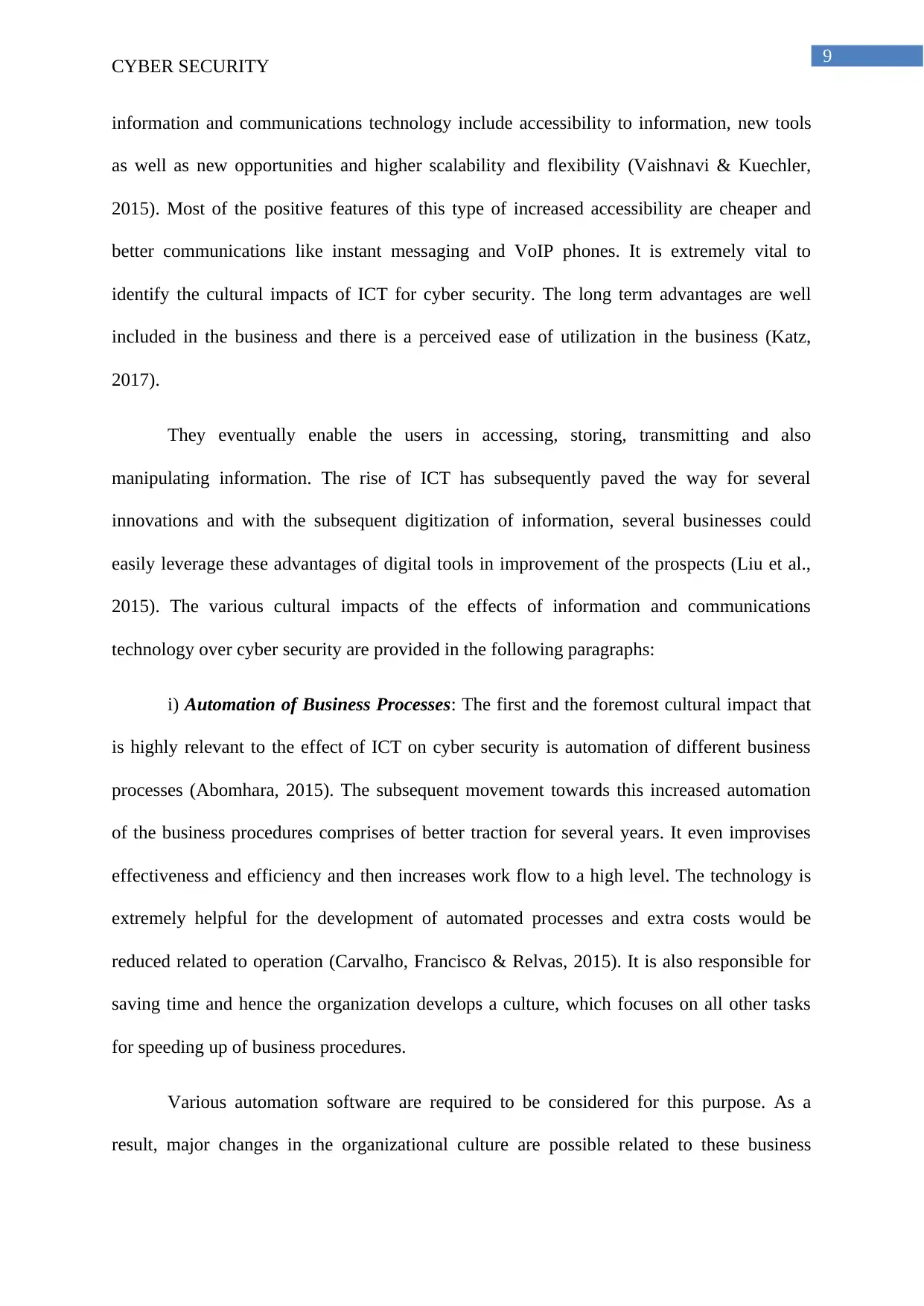
9
CYBER SECURITY
information and communications technology include accessibility to information, new tools
as well as new opportunities and higher scalability and flexibility (Vaishnavi & Kuechler,
2015). Most of the positive features of this type of increased accessibility are cheaper and
better communications like instant messaging and VoIP phones. It is extremely vital to
identify the cultural impacts of ICT for cyber security. The long term advantages are well
included in the business and there is a perceived ease of utilization in the business (Katz,
2017).
They eventually enable the users in accessing, storing, transmitting and also
manipulating information. The rise of ICT has subsequently paved the way for several
innovations and with the subsequent digitization of information, several businesses could
easily leverage these advantages of digital tools in improvement of the prospects (Liu et al.,
2015). The various cultural impacts of the effects of information and communications
technology over cyber security are provided in the following paragraphs:
i) Automation of Business Processes: The first and the foremost cultural impact that
is highly relevant to the effect of ICT on cyber security is automation of different business
processes (Abomhara, 2015). The subsequent movement towards this increased automation
of the business procedures comprises of better traction for several years. It even improvises
effectiveness and efficiency and then increases work flow to a high level. The technology is
extremely helpful for the development of automated processes and extra costs would be
reduced related to operation (Carvalho, Francisco & Relvas, 2015). It is also responsible for
saving time and hence the organization develops a culture, which focuses on all other tasks
for speeding up of business procedures.
Various automation software are required to be considered for this purpose. As a
result, major changes in the organizational culture are possible related to these business
CYBER SECURITY
information and communications technology include accessibility to information, new tools
as well as new opportunities and higher scalability and flexibility (Vaishnavi & Kuechler,
2015). Most of the positive features of this type of increased accessibility are cheaper and
better communications like instant messaging and VoIP phones. It is extremely vital to
identify the cultural impacts of ICT for cyber security. The long term advantages are well
included in the business and there is a perceived ease of utilization in the business (Katz,
2017).
They eventually enable the users in accessing, storing, transmitting and also
manipulating information. The rise of ICT has subsequently paved the way for several
innovations and with the subsequent digitization of information, several businesses could
easily leverage these advantages of digital tools in improvement of the prospects (Liu et al.,
2015). The various cultural impacts of the effects of information and communications
technology over cyber security are provided in the following paragraphs:
i) Automation of Business Processes: The first and the foremost cultural impact that
is highly relevant to the effect of ICT on cyber security is automation of different business
processes (Abomhara, 2015). The subsequent movement towards this increased automation
of the business procedures comprises of better traction for several years. It even improvises
effectiveness and efficiency and then increases work flow to a high level. The technology is
extremely helpful for the development of automated processes and extra costs would be
reduced related to operation (Carvalho, Francisco & Relvas, 2015). It is also responsible for
saving time and hence the organization develops a culture, which focuses on all other tasks
for speeding up of business procedures.
Various automation software are required to be considered for this purpose. As a
result, major changes in the organizational culture are possible related to these business
Paraphrase This Document
Need a fresh take? Get an instant paraphrase of this document with our AI Paraphraser
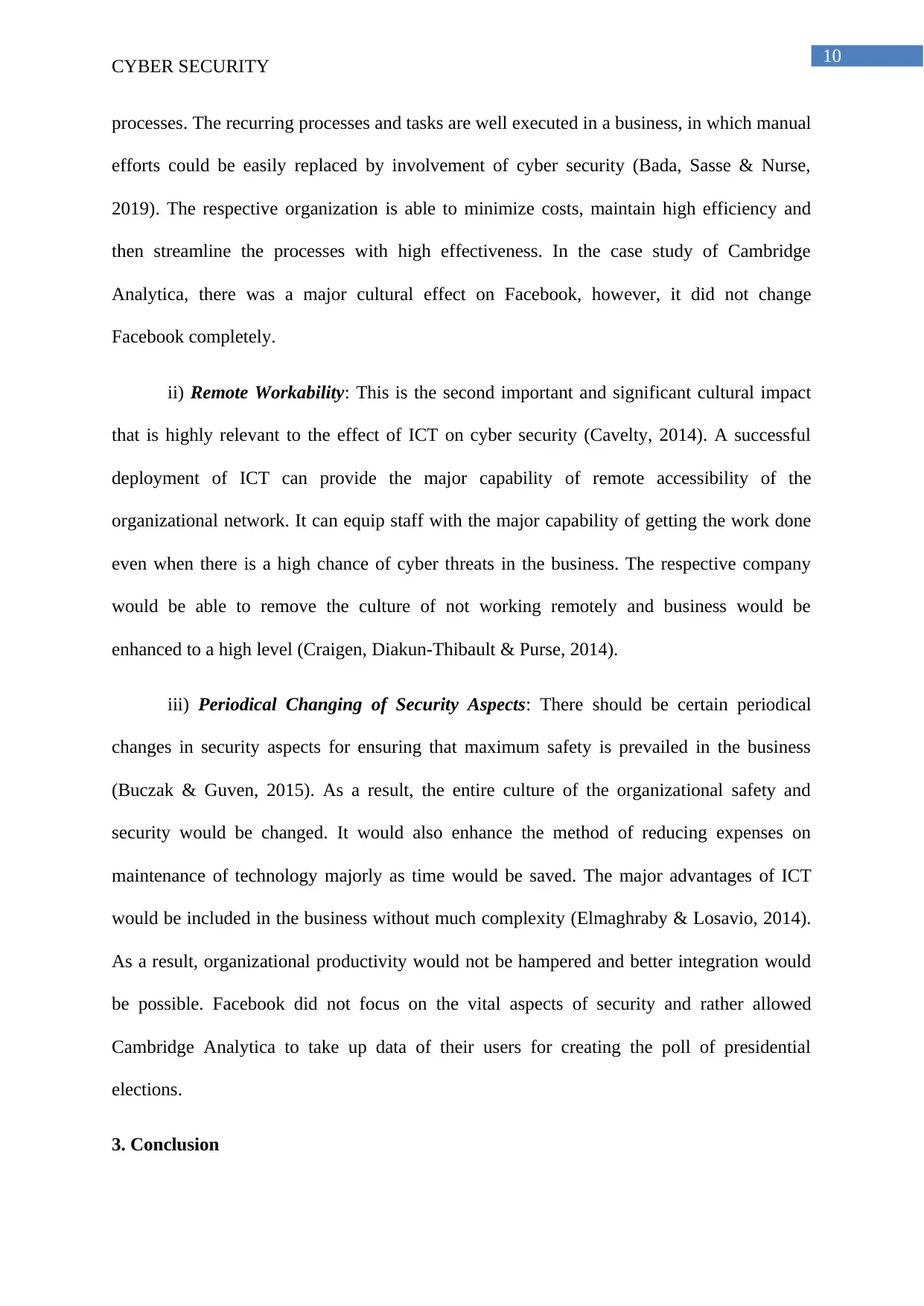
10
CYBER SECURITY
processes. The recurring processes and tasks are well executed in a business, in which manual
efforts could be easily replaced by involvement of cyber security (Bada, Sasse & Nurse,
2019). The respective organization is able to minimize costs, maintain high efficiency and
then streamline the processes with high effectiveness. In the case study of Cambridge
Analytica, there was a major cultural effect on Facebook, however, it did not change
Facebook completely.
ii) Remote Workability: This is the second important and significant cultural impact
that is highly relevant to the effect of ICT on cyber security (Cavelty, 2014). A successful
deployment of ICT can provide the major capability of remote accessibility of the
organizational network. It can equip staff with the major capability of getting the work done
even when there is a high chance of cyber threats in the business. The respective company
would be able to remove the culture of not working remotely and business would be
enhanced to a high level (Craigen, Diakun-Thibault & Purse, 2014).
iii) Periodical Changing of Security Aspects: There should be certain periodical
changes in security aspects for ensuring that maximum safety is prevailed in the business
(Buczak & Guven, 2015). As a result, the entire culture of the organizational safety and
security would be changed. It would also enhance the method of reducing expenses on
maintenance of technology majorly as time would be saved. The major advantages of ICT
would be included in the business without much complexity (Elmaghraby & Losavio, 2014).
As a result, organizational productivity would not be hampered and better integration would
be possible. Facebook did not focus on the vital aspects of security and rather allowed
Cambridge Analytica to take up data of their users for creating the poll of presidential
elections.
3. Conclusion
CYBER SECURITY
processes. The recurring processes and tasks are well executed in a business, in which manual
efforts could be easily replaced by involvement of cyber security (Bada, Sasse & Nurse,
2019). The respective organization is able to minimize costs, maintain high efficiency and
then streamline the processes with high effectiveness. In the case study of Cambridge
Analytica, there was a major cultural effect on Facebook, however, it did not change
Facebook completely.
ii) Remote Workability: This is the second important and significant cultural impact
that is highly relevant to the effect of ICT on cyber security (Cavelty, 2014). A successful
deployment of ICT can provide the major capability of remote accessibility of the
organizational network. It can equip staff with the major capability of getting the work done
even when there is a high chance of cyber threats in the business. The respective company
would be able to remove the culture of not working remotely and business would be
enhanced to a high level (Craigen, Diakun-Thibault & Purse, 2014).
iii) Periodical Changing of Security Aspects: There should be certain periodical
changes in security aspects for ensuring that maximum safety is prevailed in the business
(Buczak & Guven, 2015). As a result, the entire culture of the organizational safety and
security would be changed. It would also enhance the method of reducing expenses on
maintenance of technology majorly as time would be saved. The major advantages of ICT
would be included in the business without much complexity (Elmaghraby & Losavio, 2014).
As a result, organizational productivity would not be hampered and better integration would
be possible. Facebook did not focus on the vital aspects of security and rather allowed
Cambridge Analytica to take up data of their users for creating the poll of presidential
elections.
3. Conclusion
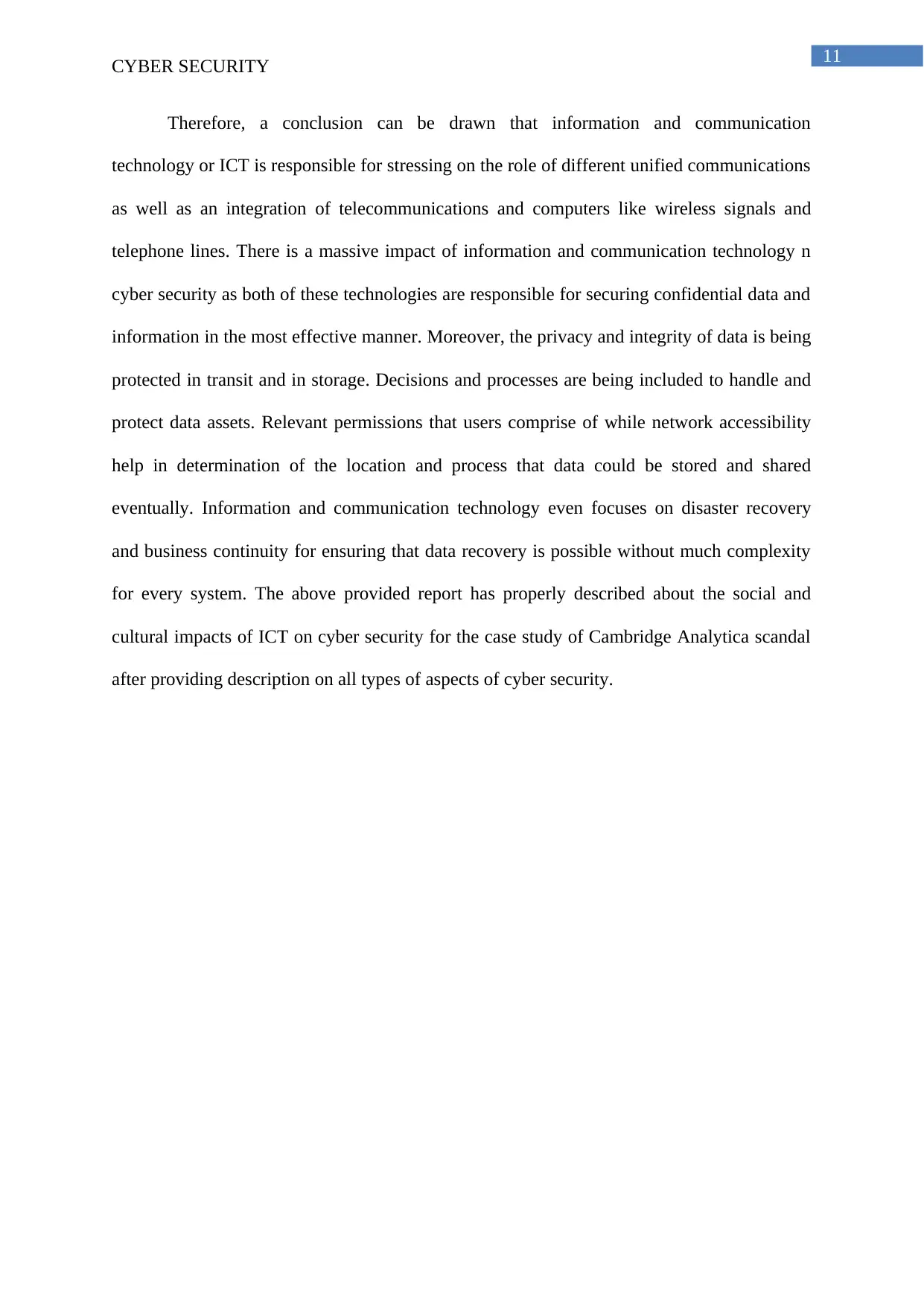
11
CYBER SECURITY
Therefore, a conclusion can be drawn that information and communication
technology or ICT is responsible for stressing on the role of different unified communications
as well as an integration of telecommunications and computers like wireless signals and
telephone lines. There is a massive impact of information and communication technology n
cyber security as both of these technologies are responsible for securing confidential data and
information in the most effective manner. Moreover, the privacy and integrity of data is being
protected in transit and in storage. Decisions and processes are being included to handle and
protect data assets. Relevant permissions that users comprise of while network accessibility
help in determination of the location and process that data could be stored and shared
eventually. Information and communication technology even focuses on disaster recovery
and business continuity for ensuring that data recovery is possible without much complexity
for every system. The above provided report has properly described about the social and
cultural impacts of ICT on cyber security for the case study of Cambridge Analytica scandal
after providing description on all types of aspects of cyber security.
CYBER SECURITY
Therefore, a conclusion can be drawn that information and communication
technology or ICT is responsible for stressing on the role of different unified communications
as well as an integration of telecommunications and computers like wireless signals and
telephone lines. There is a massive impact of information and communication technology n
cyber security as both of these technologies are responsible for securing confidential data and
information in the most effective manner. Moreover, the privacy and integrity of data is being
protected in transit and in storage. Decisions and processes are being included to handle and
protect data assets. Relevant permissions that users comprise of while network accessibility
help in determination of the location and process that data could be stored and shared
eventually. Information and communication technology even focuses on disaster recovery
and business continuity for ensuring that data recovery is possible without much complexity
for every system. The above provided report has properly described about the social and
cultural impacts of ICT on cyber security for the case study of Cambridge Analytica scandal
after providing description on all types of aspects of cyber security.
⊘ This is a preview!⊘
Do you want full access?
Subscribe today to unlock all pages.

Trusted by 1+ million students worldwide
1 out of 15
Related Documents
Your All-in-One AI-Powered Toolkit for Academic Success.
+13062052269
info@desklib.com
Available 24*7 on WhatsApp / Email
![[object Object]](/_next/static/media/star-bottom.7253800d.svg)
Unlock your academic potential
Copyright © 2020–2025 A2Z Services. All Rights Reserved. Developed and managed by ZUCOL.





